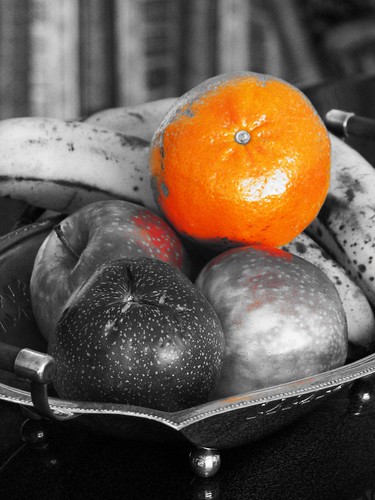Eau de Mandarine Ambrée
For a cologne with the the adjectif amber in the title, Eau de mandarine ambrée is surprisingly green. And cool.
True to the eau de cologne genre, eau de mandarine ambrée begins with a rush of bitter orange zest, whose juicy tartness is only intensified by undertones of passionfruit*. The mandarin itself is rather tart as well, rather than the characteristic sweetness of Citrus reticulata. Amber plays an interesting role, giving a cool presence rather than sweet-confectionary. Rather than embodying the honeyed and perhaps floral nuances of mandarin, it recalls crushed leaves and cool greenery in the shade of an abstract glass orchard.
For an eau de cologne, this has an astonishing longvity, although true to Ellena's style, it remains quiet and vague throughout. The amber lingers on and on - it's a clear, cool and transparent amber, not nearly as sweet as those with rich vanilla absolute and labdanum resin. Instead, it relies on distilled resins and balsams (Peru and copaiba balsams, as well as less-sweet labdanum isolates), and synthetic molecules which I know nothing about**.
The concept of amber within the refreshing, light composition of citrus and herbs is not new: Spanish-style eaux de colognes are long-known for incorporating cistus, the plant bearing labdanum resin, and an essential component of ambers. Cistus has a coniferous, herbaceous facet in addition to its resinous-amber aspect. Ellena plays with a similar concept, while conjuring modern ambery elements that carry the illusion of crushed chilled leaves and mandarin pulp to control the sweetness of amber.
* Thus continuing the theme of fruit in the refurbished eau de cologne series: Eau d'Orange Verte had the addition of mango; and Pamplemousse Rose had rhubarb ( not botanically a fruit, but considered as such by North American cooks...). The Jardin series features fruit more consistently: Fig in Mediteranee, green mango in Sur Le Nil, cantaloupe in Apres la Mousson, and pear in Le Toit.
** Except that I can recognize this as the amber same I've smelled years ago in DiorAddict, Kingdom and Nu.
True to the eau de cologne genre, eau de mandarine ambrée begins with a rush of bitter orange zest, whose juicy tartness is only intensified by undertones of passionfruit*. The mandarin itself is rather tart as well, rather than the characteristic sweetness of Citrus reticulata. Amber plays an interesting role, giving a cool presence rather than sweet-confectionary. Rather than embodying the honeyed and perhaps floral nuances of mandarin, it recalls crushed leaves and cool greenery in the shade of an abstract glass orchard.
For an eau de cologne, this has an astonishing longvity, although true to Ellena's style, it remains quiet and vague throughout. The amber lingers on and on - it's a clear, cool and transparent amber, not nearly as sweet as those with rich vanilla absolute and labdanum resin. Instead, it relies on distilled resins and balsams (Peru and copaiba balsams, as well as less-sweet labdanum isolates), and synthetic molecules which I know nothing about**.
The concept of amber within the refreshing, light composition of citrus and herbs is not new: Spanish-style eaux de colognes are long-known for incorporating cistus, the plant bearing labdanum resin, and an essential component of ambers. Cistus has a coniferous, herbaceous facet in addition to its resinous-amber aspect. Ellena plays with a similar concept, while conjuring modern ambery elements that carry the illusion of crushed chilled leaves and mandarin pulp to control the sweetness of amber.
* Thus continuing the theme of fruit in the refurbished eau de cologne series: Eau d'Orange Verte had the addition of mango; and Pamplemousse Rose had rhubarb ( not botanically a fruit, but considered as such by North American cooks...). The Jardin series features fruit more consistently: Fig in Mediteranee, green mango in Sur Le Nil, cantaloupe in Apres la Mousson, and pear in Le Toit.
** Except that I can recognize this as the amber same I've smelled years ago in DiorAddict, Kingdom and Nu.


